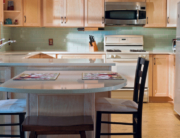Few appliances in your home get more traffic than the fridge—which is why it’s good to know that there are actually many different types of refrigerators. Selecting the right style for your family is more than just a fashion choice. A fridge must serve many masters like space, price, and even such factors as whether you have a bad back, dig leftover pizza out of the original carton, or have a constant need for fresh ice for your cocktails (or, um, water).
“There are several things to consider when finding which fridge style is best for you,” says David VanderWall, a vice president of marketing for LG Electronics USA. “Are you a culinary expert, or are you more interested in the practical features of your fridge? Another factor is the physical space available in your kitchen. In short, it’s really worth it to choose right.”
Whether you’re shopping for a new fridge or just wondering whether you have the right one, check out this guide on the various types of refrigerators, plus their pros, cons, and price ranges.
Top-mount freezer
Description: This traditional model has separate doors for a small freezer on top and large refrigerator on bottom. It’s typically 30 to 33 inches wide with capacity of about 22 cubic feet.
Pros: It’s the most economical style with lowest upfront costs.
Cons: You have to stoop to load and unload the refrigerator, which is what you’ll use most. Vegetable and fruit crispers often are on the very bottom and, depending on how flexible you are, could be a pain to open, shut, and clean.
Average price: $500 to $800
Bottom-mount freezer
Description: The freezer is on the bottom, and the refrigerator is on the top. It’s typically 30 to 36 inches wide, and capacity approaches 30 cubic feet. Most models have pull-out freezer drawers.
Pros: It’s easier to see the food you select most often, which is easier on your back and neck. Bottom freezers generally have more capacity than top-mount freezers.
Cons: You’ll have to bend to pull out ice cream and frozen dinners.
Average price: $1,000 to $1,800
Side-by-side
Description: This model is divided vertically into freezer and refrigeration space, and often includes in-door ice makers and water dispensers. Width ranges from 32 to 36 inches with capacity of 30 cubic feet.
Pros: Most people love the in-door ice maker/water dispenser, and the narrow doors require less swing space, which is good for small kitchens. Freezer capacity often is greater than other models, which is good if you buy in bulk.
Cons: It can’t hold wide items like pizza boxes or party trays, and it’s less energy-efficient than other models, according to the Consumer Energy Center.
Average price: $1,800
French door
Description: Much like french doors that open into a room, a french door fridge (also called a café fridge) features two side-by-side doors on top that open to one large unpartitioned space inside. The freezer is a drawer on the bottom; some models also have a narrow drawer between for fruits and vegetables. Size ranges from 30 to 36 inches wide, with up to 30 cubic feet of capacity.
Pros: There’s wide space in the refrigerator for platters that won’t fit in a side-by-side model. Two narrow doors require less swing space, which is nice in smaller kitchens.
Cons: Unless you use both hands to open both doors, you can see only half the fridge at a time. If your short-term memory isn’t tops, you’ll always be opening the wrong door when you want a pint of yogurt.
Average price: $1,500 to $2,700
Built-in
Description: These refrigerators, which come in many styles, are flush with cabinets, which give them a built-in look (think Sub-Zero or Viking models found in high-end houses). They are typically 36 inches wide with 25 cubic feet of capacity.
Pros: Their sleek beauty can be customized with a front panel that matches cabinetry, which makes the appliance virtually disappear.
Cons: They’re pricey and wider than many models, which requires more space.
Average price: $7,000 to $10,000
This article was originally published at Realtor.com.






